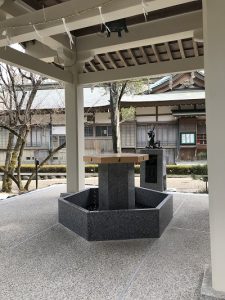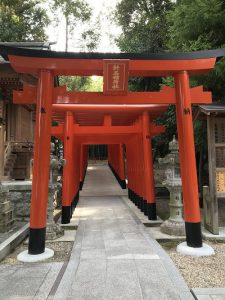マイひしゃくの時代到来(愛知県名古屋市千種区姫池通 古美術買取いたします 古美術風光舎名古屋店)
2022.03.19
皆さまこんにちは
毎年寒がりで、ぎりぎりまでセーターを着ている、スタッフNでございます。
だいぶ暖かくなってまいりましたね。
毎年トレンチコートを買うか悩んでいるのですが、今年もユニクロのライトダウンで乗り越えそうです。
レザージャケットなんかもかっこいいですね。
皆さまはどんな装いでお出かけでしょうか?
先日神社にお参りに行ってまいりました。
本来なら、毎月1日と15日に行きたいのですが、ずぼらな私は毎回忘れてしまいます。(3か月ぶりの参拝でございます)

神社・仏閣の参拝をする前に、自分自身を「清める」行為は必ず行うべきものですよね。神さまや仏さまの前に立つ前に、参拝時には手水舎(てみずや、ちょうずや)に立ち寄り、身体を清めるときに、左が先? 右が先? と毎回不安になってしまうこともしばしば。手水の作法は、神社であっても、寺であっても、原則は同じだそうです。神社と仏閣に共通する作法として、参拝前に手水の作法を改めて確認してみました。

1:心静かに立つ
参拝の前に手や口を清めるための、手水舎に到着したら、まずは心を落ち着けてまっすぐ立ちます。
なお、手水の作法は神社のものなので、お寺の場合は神社に準じて、同様に行えば問題ありません。
2:最初に水をくむのは右手で
手水の作法に移る前に軽くおじぎをします。これは、鳥居、門などをくぐるときなどにも必要な作法です。そして、まずは右手で柄杓(ひしゃく)を持ち、水をくみます。柄杓が水で満杯になる程度が水の量の目安です。
3:左手を清める。目安は3割
まずは左手を清めます。このときに使う水の量は、全体の3割が目安となります。基本的に神仏関連の作法は、左が上位にあるので、左からはじまることが多いです。
4:左手に持ち替え、次は右手を
清められた左手に柄杓を持ち替えて、今度は右手を清めます。同じく使用する水の量は3割程度を目安にするとよいでしょう。柄杓を持ち替えるときに、水をこぼさないように注意しましょう。
5:口を清めるために左手で水を受ける
手を清め終わったら、続いて口をすすぐため、再び清めた右手に柄杓を持ち替え、右手の柄杓から左手へ水を注ぎます。左手で水を受けるとき、柄杓に水を1割程度残すくらいまで水は使用してしまって大丈夫です。
6:口を清める
左手に受けた水を口に運び、口をすすぎます。手水の作法において、口に直接、柄杓を運ぶようなことはしてはいけません。過去にそのような行為をした覚えがあれば、注意してください。これで、手と口の清めは終わりです。
7:柄杓を清める
最後に柄杓に残った水で、使用した柄杓を清めます。柄杓を立て、柄に水を伝わせて、自分が持っていた柄の部分まで水を流します。このとき、衣服を濡らさないように、動作はゆっくりと行うのがよいでしょう。
8:柄杓を元に戻す
柄杓を清め終えたら、元の場所に戻します。次に使う人のことを考えて、丁寧に置くことを心がけてください。最期に手水舎から離れる際には最初と同じく、軽くおじぎをしてから立ち去ります。手水の作法は、“礼にはじまり礼に終わる”と覚えておきましょう。
以上が手水の作法でございます。
知っているようで知らないことがたくさんありました。
手水の前と後にも軽くお辞儀をするのですね。
お辞儀をするタイミングがわからず、気づけば6回くらいしてしまっているような気が致します。
さあ、いざ神社で実践・・・と行きたいところですが、残念ながら昨今のご時世のせいで、手水をすることができませんでした。

なんと、近づくと水が落ちてくる、全自動式になっておりました。
これはこれで楽なのですが、なんだか少し寂しい気も致しますね。
この使用になってから、全国からひしゃくが撤去されてしまい、神主さんや関係の方から、なんとかならないかという要望が来たそうです。
そんな中“マイひしゃく”を作ったのが、岐阜市内にある神棚などを製造販売する会社。
色々調べたところ、ミニマイひしゃく、マイひしゃくを入れる袋、マイひしゃく専用のスタンド、なんていうのもございました。
根付のストラップ付きのひしゃくは、でんでん太鼓のようで可愛らしかったです。
マイひしゃく、ひしゃく入れ、ひしゃくスタンドまでそろえれば、使いたくて毎月お参りに行きそうでございますね。
皆さまも、マイひしゃく持参で近所の神社に行かれてみてはいかがでしょうか?
今までとは違う新たな発見があるかもしれません。
ではでは

Hello everyone
This is Staff N, who wears a sweater to the last minute because it gets cold every year.
It’s getting warmer.
I’m worried about buying a trench coat every year, but I think I’ll be able to overcome it with UNIQLO’s light down this year as well.
The leather jacket is also cool.
What kind of clothes do you wear when you go out?
I went to a shrine the other day.
Originally, I would like to go on the 1st and 15th of every month, but I’m sloppy and forget about it every time. (This is the first visit in 3 months)
Before visiting a shrine or temple, you should definitely “cleanse” yourself. Before standing in front of the gods and buddhas, stop by the Chozuya (Temizuya, Chozuya) when worshiping, and when you cleanse your body, the left is first? Right first? I often get anxious every time. It seems that the principle of hand water is the same regardless of whether it is a shrine or a temple. As a manner common to shrines and temples, I reconfirmed the manners of hand water before worshiping.
1: Stand quietly
When you arrive at the Chozuya to cleanse your hands and mouth before worshiping, first calm down and stand straight.
In addition, since the method of hand water is that of a shrine, in the case of a temple, there is no problem if you follow the shrine and do the same.
2: The first thing to draw water is with your right hand
Bow lightly before moving on to the etiquette of hand water. This is also necessary when going through torii gates and gates. Then, first hold the Hishaku with your right hand and draw water. The amount of water is a guideline for the amount of water that the cassotte is filled with water.
3: Clean your left hand. The standard is 30%
First, cleanse your left hand. As a guide, the amount of water used at this time is 30% of the total. Basically, gods and Buddha-related manners often start from the left because the left is at the top.
4: Switch to the left hand, then the right hand
Change the handle to the cleansed left hand, and this time cleanse the right hand. Similarly, the amount of water used should be about 30%. Be careful not to spill water when changing the handle.
5: Receive water with your left hand to cleanse your mouth
After purifying your hands, change the ladle to the cleansed right hand and pour water from the ladle of your right hand to your left hand to rinse your mouth. When you receive water with your left hand, it is okay to use the water until you leave about 10% of the water in the hishaku.
6: Clean your mouth
Bring the water you received in your left hand to your mouth and rinse your mouth. In the etiquette of hand water, do not carry the hishaku directly to your mouth. If you remember doing such an act in the past, be careful. This is the end of cleansing hands and mouth.
7: Purify the Hishaku
Finally, clean the used Hishaku with the water remaining in the Hishaku. Set up a hishaku, let the water flow through the handle, and let the water flow to the part of the handle that you had. At this time, it is best to move slowly so as not to get your clothes wet.
8: Put back the Hishaku
After purifying the hishaku, put it back in its original place. Please think about the next person to use and put it carefully. When you leave the Chozuya at the end, just bow lightly and then leave. Remember that the method of hand water is “beginning and ending with gratitude.”
The above is the method of hand water.
There were many things I seemed to know but didn’t know.
You bow lightly before and after the water.
I don’t know when to bow, and if I notice it, I feel like I’ve done it about 6 times.
Now, I’d like to practice at a shrine, but unfortunately I couldn’t do water because of the times these days.
It was a fully automatic system in which water fell when approaching.
This is easy with this, but I feel a little lonely.
Since this use, the Hishaku has been removed from all over the country, and it seems that the priest and related people have requested that something be done.
Meanwhile, “My Hishaku” was created by a company that manufactures and sells Kamidana in Gifu City.
As a result of various investigations, there were also mini-my-hishaku, a bag to put my-hishaku, and a stand dedicated to my-hishaku.
The Hishaku with the netsuke strap was cute like a Denden daiko.
If you have my own Hishaku, Hishaku Hishaku, and Hishaku stand, you will probably want to use it and go to visit every month.
Why don’t you bring your own Hishaku to a nearby shrine?
There may be new discoveries that are different from the past.
See you soon
**********************
三月にはいりました。
暖かくなり、また新しい年度に向けてお片付けをはじめられた方もいらっしゃるのではないでしょうか。
生活様式の変化とともに、大切なお品を整理されている方も多いことと思われます。
ここ古美術風光舎では、古美術品や骨董品の他にも絵画や宝石、趣味のお品など様々なジャンルのものを買受しております。
お片付けをされていて、こういうものでもいいのかしらと迷われているものでも、どうぞお気軽にご相談下さいませ。
古美術風光舎は、出張買取も強化しております。
愛知県内はもちろん、岐阜県・三重県その他の県へも出張いたします。
どんなにご近所の方でもお伺いできますので、まずはお電話お待ちしております。
愛知県名古屋市千種区・骨董 買取
『古美術 風光舎 名古屋店』
TEL 052(734)8444
10:00-17:00 OPEN

